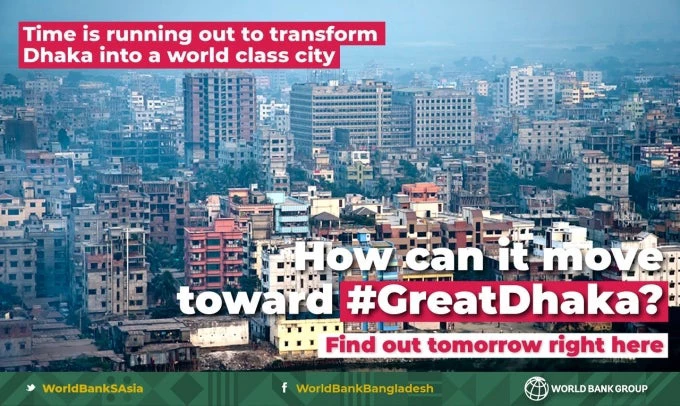
Read Press Release
Originally Appeared on the Daily Star
Had you looked across Shanghai's Huangpu River from west to east in the 1980s, you would mostly have seen farmland dotted with a few scattered buildings. At the time, it was unimaginable that East Shanghai, or Pudong, would one day become a global financial centre; that its futuristic skyline, sleek expressways, and rapid trains would one day be showcased in blockbusters like James Bond and Mission Impossible movies! It was also unimaginable that the Shanghainese would consider living in Pudong.
How wrong that would have been! Pudong is now hosting some of the world's most productive companies, and boosting some of the city's most desirable neighbourhoods. And Shanghai has become China's most important global city, lifting the entire hinterland with it.
The same potential for urban transformation exists in Bangladesh, across the Pragati Sarani Airport Road that divides Dhaka into its west and east. West Dhaka is urban, hosting vibrant centres. East Dhaka remains largely rural, with a vast expanse of farmland. This sharp contrast presents a golden urban development opportunity for Dhaka, one that is not available to other major Asian cities.
Dhaka's population has grown from three million in 1980 to 18 million today and it continues to increase rapidly, which is a clear sign of success. However, Dhaka's development has been mostly spontaneous, with its urban infrastructure not keeping pace with its population growth.
Dhaka's citizens are confronted with three challenges every day. Flooding and water-logging are recurrent, with monsoon rainfalls and river overflows often bringing the city to a standstill. The average driving speed has dropped from 21 kilometres per hour to less than seven kilometres per hour, and continues to slow toward walking pace. Congestion consumes millions of working hours per day. The city is also messy in other ways. Three-and-a-half million of its citizens currently live in slums and lack access to basic services. Air, soil and water quality has deteriorated to alarming levels.
Without taking decisive action now, these problems will only get worse, as Greater Dhaka will be home to 25 million people by 2035. Continuing business-as-usual is not the answer.
The World Bank's just released report, "Toward Great Dhaka: A New Urban Development Paradigm Eastward", lays out a strategic vision for the city to unlock the potential of East Dhaka . This area is as large in surface as a major European city, and much of it is located within a few kilometres of the most valuable parts of the city. East Dhaka thus has the potential to become a new urban centre that will help alleviate the challenges faced by West Dhaka and make the entire city more prosperous and liveable. Inspired by the success of Pudong, Shanghai, but based on Dhaka's reality and state-of-the-art economic modelling and simulations, the report recommends three interventions to develop East Dhaka. These interventions are all based on existing plans and studies for Dhaka and actually amount to a prioritisation exercise, emphasising what is most critically important given the urgency of the situation. Their selection was guided by multiple consultations with urban authorities, technical experts and civil society, including a major conference held in Dhaka one year ago.
The three selected interventions are: building the eastern embankment along the Balu River, accompanied by canal rehabilitation and preservation, to mitigate flooding; developing transport links and public transit, to ease congestion; and creating a world-class business district with sound policies, to attract firms and residents eastward.
These three critical interventions are projected to cost USD 15 billion. But the return on the investments is an enormous USD 53 billion boost to annual economic output by 2035. If implemented, these three interventions will enable the capital to comfortably host five million more people and to create 1.8 million new and better jobs, in comparison with a continuation of business as usual.
The average income per capita in Dhaka could reach more than USD 9,200 by 2035 compared to less than USD 8,000 on current trends. This would help put Dhaka on the list of global cities. It would also enable Dhaka to become a stronger economic powerhouse for Bangladesh as well as a regional hub connecting emerging economic corridors between South and Southeast Asia.
But time is running out. Many parts of East Dhaka are being developed spontaneously: private developers are filling vast tracts of land with sand, and households and firms are encroaching the edges of the few roads there. Action must be taken now to avoid replicating the messy development of West Dhaka. Spontaneous development is also creating new disaster, environmental and social risks. Fixing East Dhaka in the future will be much more expensive and difficult, even riskier.
As Pudong's story suggests, the success of a strategic vision in such a scale will depend on a strong political will, a clear mandate by authorities, good coordination between institutions and concerted implementation. While the myriad of overlapping authorities has plagued Dhaka's development in the past, the stellar example of Hatirjheel Lake rehabilitation project shows that bold urban development initiatives are possible in Bangladesh.





Join the Conversation